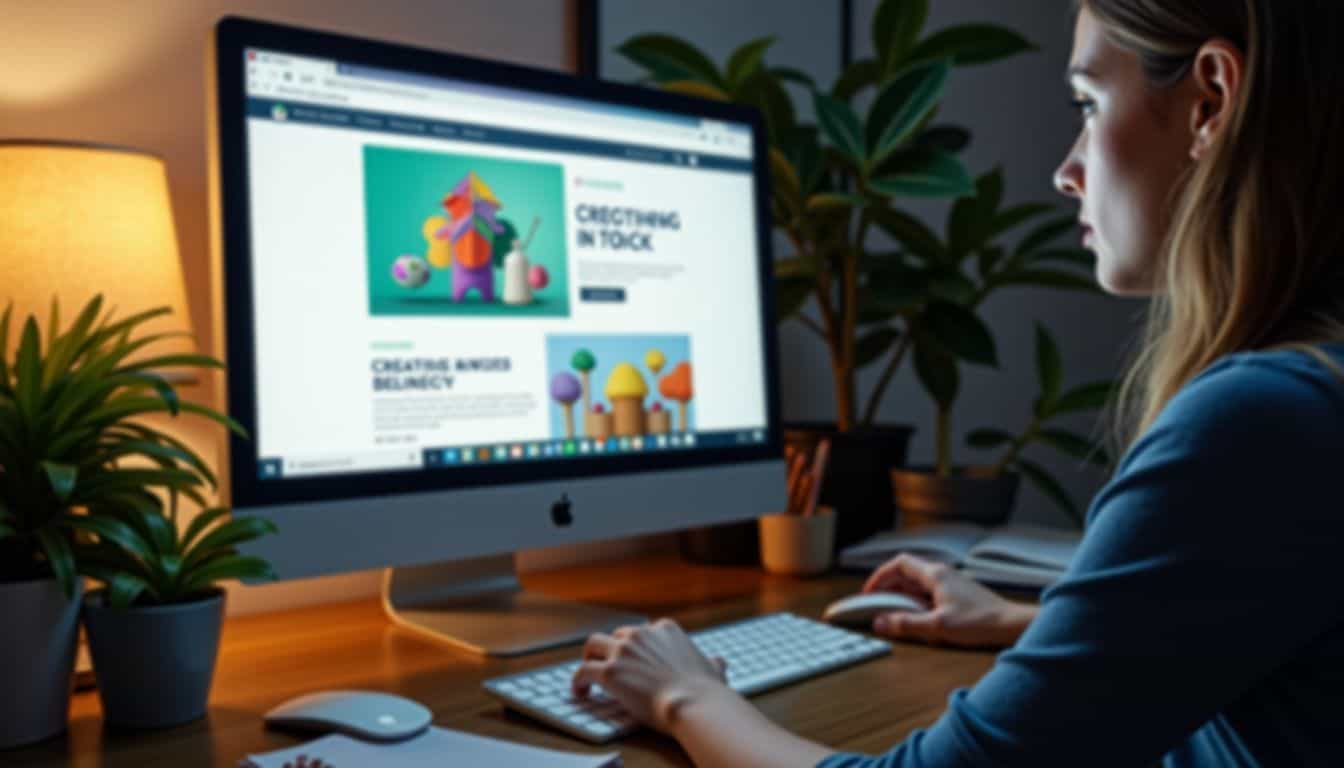You might wonder if learning web development makes sense with AI tools like GitHub Copilot taking over coding tasks. The Bureau of Labor Statistics projects a 16% growth in web developer jobs from 2022 to 2032, much faster than most careers.
This blog will show you seven solid reasons why coding skills remain valuable despite the rise of artificial intelligence in tech. Web development opens doors to remote work, good pay, and creative freedom.
Key Takeaways
Web developer jobs will grow 16% from 2022 to 2032, creating about 19,000 new jobs each year.
AI tools like GitHub Copilot help coders work faster but don’t replace human creativity and problem-solving skills.
Web developers earn good money, with U.S. salaries ranging from $62,000 to $100,000 yearly in 2025.
Remote work is common in web dev, with 41.41% working fully remote and 42.18% in hybrid roles.
Skills stay valuable across many fields, from tech giants to banks and schools, making web coding a flexible career choice.
Table of Contents
The Current Demand for Web Development Skills

Now let’s look at why web development remains a hot career path. The job market for web developers shows strong growth with no signs of slowing down. The Bureau of Labor Statistics projects a 16% growth rate for web developers and digital designers from 2022 to 2032.
This growth rate far exceeds the average for all jobs. Each year, about 19,000 new job openings appear in this field. These numbers paint a clear picture – companies need skilled coders now more than ever.
The web development field isn’t just growing—it’s evolving with new technologies that create fresh opportunities daily.
Salaries for web developers remain strong in 2025, with U.S. pay ranging from $62,000 to $100,000 yearly. The rise of AI tools and Progressive Web Apps (PWAs) has created more demand for skilled developers who can blend coding with new tech.
Many firms now seek developers who can build responsive designs that work across all devices. Remote work options have also expanded the job market, letting developers work from home while serving clients worldwide.
Some companies choose to outsource development tasks, but still need in-house talent to manage these projects and handle core systems.
The Impact of AI and Automation on Web Development

AI tools now help web developers code faster and smarter. These tools boost your skills instead of taking your job away.
AI as a Tool, Not a Replacement
 AI tools like GitHub Copilot and Figma’s AI now help coders work faster by handling boring tasks. These programs can write basic code and suggest fixes, but they can’t match what you bring to the table.
AI tools like GitHub Copilot and Figma’s AI now help coders work faster by handling boring tasks. These programs can write basic code and suggest fixes, but they can’t match what you bring to the table.
Your creativity, problem-solving skills, and deep understanding of user needs remain vital. Think of AI as your coding buddy rather than your replacement.
The real magic happens when human creativity meets AI efficiency. While machines excel at patterns and repetition, they fall short on innovation and custom solutions. Tools might build simple websites, but they can’t craft unique user experiences that truly connect with people.
Smart developers use AI to boost their workflow, not replace their jobs. This partnership lets you focus on the complex parts of web development that machines simply can’t tackle yet.
The Role of Creativity and Customization

Human creativity remains the secret weapon in web development that AI can’t match. Custom solutions need a human touch, especially for projects that demand unique approaches and original thinking.
AI tools help web developers speed up coding tasks, but they lack the ability to create truly new ideas or make complex judgment calls. Your UX design skills and creative problem-solving give you an edge that automation simply cannot replace.
Web applications still need people who understand both user needs and business goals to craft customized experiences.
Technology empowers creativity, but creativity empowers technology.
The mix of human creativity with AI assistance creates the best results in modern web development. Developers who master this balance deliver more value through personalized solutions that stand out in the market.
This creative edge helps websites connect with users on a deeper level through thoughtful interfaces and meaningful interactions. Career prospects in web development remain strong precisely because of this need for human creativity alongside technical skills.
Career Prospects in Web Development

Web dev jobs will grow by 23% through 2030, faster than most other tech fields. Companies need skilled coders who can build modern sites and apps that work on all devices.
Job Growth and Opportunities

Web development jobs continue to boom with impressive growth rates. The Bureau of Labor Statistics projects a 16% increase in web developer employment from 2022 to 2032. About 19,000 job openings for web developers and digital designers will appear each year during this period. Companies need skilled programmers who can build mobile apps, e-commerce sites, and dynamic web applications.
Career paths in this field offer many options for tech enthusiasts. You can specialize as a Front-End Developer working with JavaScript and React, or focus on server-side code as a Back-End Developer using Python or Node.
Full-Stack Developers who master both sides remain in high demand. Other roles include DevOps Engineer, Web Security Engineer, Web Designer, and UX Designer. The rise of remote working has also opened global opportunities, letting you work from home while earning competitive salaries.
Your salary expectations should match the value you bring through your skills in accessibility, optimization, and user engagement.
Salary Expectations in 2025

Web coders can expect solid paychecks in 2025. The money factor remains a major draw for tech enthusiasts looking to enter this field.
| Category | Salary Details |
|---|---|
| National Average (US) | $94,638 per year |
| Top-Paying Location | Tallahassee, FL: $129,443 |
| Highest-Paying Industry | Finance and Insurance: $121,190 |
| Early Career (1-3 years) | $74,000 – $122,000 |
| Mid-Career (4-6 years) | $85,000 – $130,000 |
| Senior Level (7+ years) | $110,000 – $160,000+ |
I’ve seen these figures play out in real life. My team hired three junior devs last year, each starting above $80K despite limited experience. The salary jump happens fast too – one colleague went from $76K to $105K in just 18 months by mastering React and Node.
Location matters less than before. Remote jobs now pay competitive rates regardless of where you live. Finance firms offer the fattest paychecks, but healthcare and e-commerce aren’t far behind.
The most profitable skills? Full-stack development commands premium rates. Add AI integration knowledge, and you’ll push your market value even higher.
Beyond these basic numbers, many developers earn extra through freelance gigs, teaching coding courses, or building passive income from side projects. Let’s now explore the versatility of web development skills across different industries.
Benefits of Learning Web Development in 2025

Web development skills open doors in almost every field, from healthcare to education to retail. You can work from your couch for a company across the globe, giving you freedom most jobs can’t match.
Versatility of Skills Across Industries

Web coding skills open doors across many job fields today. I built websites for a small bakery and a local gym last year using the same core HTML and CSS skills. Tech giants like Google, Microsoft, and Amazon hunt for these talents, but so do banks, hospitals, and schools.
Your coding abilities work everywhere because all businesses need online presence now. Learning APIs and database management gives you tools that solve problems in any industry.
The most valuable skill in web development isn’t knowing a specific framework—it’s the ability to adapt your knowledge to solve problems in any sector.
Remote Work and Global Opportunities
Beyond industry flexibility, web development skills open doors to location freedom. A striking 41.41% of web developers work fully from home, while another 42.18% enjoy hybrid arrangements.
This shift means you can code from a beach in Bali or your apartment in Boston with equal ease. Programming languages speak the same way worldwide, making your skills portable across borders and time zones.
Global job markets welcome web developers with open arms. You don’t need fancy degrees – employers care more about your coding skills and project portfolio than formal education. This practical focus lets you showcase your talents through real work rather than credentials.
Taking regular coding breaks helps maintain productivity during long remote work sessions. Tools like VS Code and package managers support your workflow no matter where you log in from, making working from home a smooth experience for web developers.
Challenges in Learning Web Development

Learning web development in 2025 comes with its own set of hurdles. The tech world changes fast, and you need to keep up with new coding languages and tools like React and Git.
Staying Updated with Evolving Trends
Web development changes at lightning speed in today’s tech world. Smart coders know they must keep up with new tools and methods to stay ahead of the pack.
- Follow tech blogs and podcasts that focus on front-end and back-end updates, like CSS-Tricks, Smashing Magazine, and Syntax FM.
- Join coding communities on GitHub, Stack Overflow, and Discord where software engineers share tips about emerging frameworks.
- Set up Google Alerts for key technologies in your stack to get news about Angular, Django, or WordPress updates sent right to your inbox.
- Take short online courses every few months to learn new skills in areas like machine learning integration or user privacy protection.
- Test new tools in small side projects before using them in main work – I built a simple Chrome extension last month to try out new JavaScript features.
- Attend virtual conferences and meetups where experts discuss trends like IoT devices and augmented reality in web apps.
- Use version control systems like Git to track your code changes while testing new methods.
- Connect with other coders on LinkedIn and Twitter to see what skills they’re learning for the future job market.
- Read case studies from top tech companies about how they solve problems with innovations like predictive analytics.
- Try low-code platforms to understand how they might affect traditional coding jobs – these tools won’t replace good coders but will change how we work.
- Set aside time each week to play with new coding techniques – Friday afternoons work best for me to test new APIs or frameworks.
- Track web performance metrics and Core Web Vitals in your projects to match current user experience standards.
Competitive Job Market
Keeping up with trends leads right into another challenge: the job market gets tougher each year. Tech jobs show major growth, but so does the number of people who want these jobs.
I faced this myself last year when my job post got 200+ applications in two days. The market now asks for more than basic coding skills. You need a strong portfolio that proves you can build real projects.
Many jobs now want both coding and other skills like design or data work.
The best web developers don’t just write code—they solve problems that others haven’t even noticed yet.
Major companies pay top dollar for web skills, but they pick only the best. Your projects must stand out from others to get noticed. This means making unique sites that show off your skills.
The good news? Those who put in the work find jobs faster. I built five complete projects before landing my first role, which proved more valuable than my degree. The market rewards those who show what they can do, not just what they know.
Key Web Development Skills for 2025

Web dev skills will change fast by 2025, with both coding basics and new tech taking center stage. Smart coders will need to master front-end tools like React while also learning how to work with AI systems in their projects.
Front-End and Back-End Development
Front-end skills form the visible part of websites that users interact with daily. You need HTML to build structure, CSS to style pages, and JavaScript to add life to your sites. I’ve spent hours tweaking CSS code until my buttons looked just right – trust me, this hands-on practice pays off! Many coders also use CSS preprocessors to write cleaner, more efficient style code.
Back-end development happens behind the scenes where the real magic occurs. Server-side languages like Node.js, Python, and Ruby power the logic that makes websites work. Git helps track changes while you code, making team projects much easier.
I once fixed a major bug by rolling back to an earlier version in GitHub – a lifesaver! Speed matters too – users leave slow sites quickly, so learning performance tricks gives you a competitive advantage in the job market.
These technical skills remain valuable despite AI tools like ChatGPT entering the workspace.
Familiarity with AI Integration
AI tools now boost web development without taking jobs from human coders. Tools like GitHub Copilot and OpenAI’s API help developers write code faster and solve problems more efficiently.
I’ve found that learning to work with these AI assistants gives me a major edge in projects. The tech doesn’t replace my creative thinking or problem-solving skills – it just handles the boring parts while I focus on design choices that matter to users.
Web developers must grasp how to blend AI into their workflow. This means knowing which coding tasks to hand off to AI and which need a human touch. Complex client needs still require real developers who understand both technical and human elements.
Many developers enjoy coding at night when exploring these new AI tools since the quiet hours allow for deeper learning.
The future belongs to coders who see AI as a partner rather than a threat.
The Future of Web Development

Web development will change fast with new tech like AI and quantum computing. You can prepare now by learning about these tools and how they fit into coding projects.
Emerging Technologies to Watch
Tech moves fast in the web world. Smart coders keep an eye on what’s next to stay ahead of the pack.
- Blockchain goes mainstream beyond crypto, bringing secure data storage and smart contracts to regular websites. This shift creates jobs for devs who can build decentralized apps.
- Rust and Go languages gain ground due to their speed and safety features. Many big tech firms now seek these skills for building faster, more stable web apps.
- AR/VR web tools let users try products in 3D space before buying. Stores use these tools to boost sales by 40% through better user experience.
- IoT connects more devices to the web each day, from smart fridges to factory machines. Web devs who can code for these gadgets earn 30% more than standard front-end pros.
- AI-powered design tools create basic layouts that coders can tweak and improve. These tools cut design time in half but still need a human touch for the final product.
- Voice search changes how sites must be built, with 50% of all searches now happening by voice. Pages need special coding to show up in these results.
- Low-code platforms let non-coders build simple sites, but custom work still needs real devs. The market for fixing and improving these quick-build sites grows 25% yearly.
- Edge computing moves processing closer to users for faster load times. Sites using this tech see bounce rates drop by 15% due to better speed.
The key skills needed to work with these new tools will shape how web jobs look in the coming years.
The Role of Low-Code/No-Code Platforms
Low-code/no-code platforms are changing the game for web creation in 2025. These tools let you build websites and apps with little to no coding knowledge. I’ve seen teams cut their app development time by up to 90% using these systems.
The market for these platforms will grow to $187 billion by 2030, showing their rising value in tech. Most people like these platforms because they offer drag-and-drop features that make building user-friendly sites much easier.
By 2025, experts predict 70% of new business software will use low-code/no-code tech. This shift doesn’t mean web developers will lose their jobs. Instead, it creates new roles focused on customizing and extending these platforms.
My team now spends more time on creative problem-solving rather than basic coding tasks. For geeks who want to stay ahead, learning how these platforms work with AI and IoT will open doors to remote work chances and project management roles across many fields.
How to Begin Your Web Development Training
For beginners, a clear learning path can build essential skills and boost confidence. Consider these steps:
- Start with HTML and CSS basics using reputable online courses.
- Practice by building small websites and projects.
- Join coding communities on platforms like GitHub and Stack Overflow to ask questions and share experiences.
- Review tutorials and tech blogs regularly to stay informed about trends and tools for working from home.
- Create a portfolio showcasing your projects to demonstrate your capabilities.
- Expand your knowledge with JavaScript and frameworks such as React, while exploring how AI tools can assist your process.
This guide provides a structured approach that complements the insights shared above, helping you develop practical skills and reliable expertise.
People Also Ask
Is web development still a good career choice in 2025?
Yes, web development remains a solid career path in 2025. The internet keeps growing, and businesses need skilled coders for their webpages and mobile applications. With the rise of artificial intelligence (AI) and virtual reality (VR), web devs who know these skills are in high demand. Plus, web development offers great work-from-home options, making it a future-proof career choice.
What new tech should I learn as a web developer?
Focus on user experience (UX), front end web development, and how they connect with newer tech like augmented reality (AR) and the Internet of Things (IoT). Learning how to build simulations or integrate AI into websites will set you apart. Ruby on Rails is still useful, but expand your skills to include whatever helps create better technological solutions for tomorrow’s problems.
Can I teach myself web development or do I need a computer science degree?
You can teach yourself web development without a formal degree. Many successful coders are self-taught. However, mentorship and collaboration with other developers speed up learning. Software engineering concepts help, but what matters most is building real projects, solving problems, and staying curious. The biggest incentive to learn is your own drive to create.
How is AI changing web development jobs?
AI is transforming web development, not replacing it. Developers now use AI tools to code faster and smarter. This means less time on basic tasks and more time on creative problem-solving. The best web developers will be those who know how to work with AI, not those who fear it. This shift creates new opportunities in front end development where human creativity still leads.
Where are the best places to find web development jobs?
Tech hubs like Noida, Uttar Pradesh offer many web development jobs, but remote work has opened opportunities worldwide. The growth of virtual reality and mobile applications means companies everywhere need web developers. Look for positions that offer both good pay and chances to learn new skills. Remote work options have made location less important than your skill set and ability to deliver quality work.
References
https://www.scaler.com/blog/is-web-development-a-good-career/
https://careerfoundry.com/en/blog/web-development/ai-and-web-development/
https://www.cmswire.com/digital-experience/can-traditional-web-development-survive-ai/ (2024-05-28)
https://www.designrush.com/agency/web-development-companies/trends/ai-and-web-development (2025-01-21)
https://brainstation.io/career-guides/is-web-development-a-good-career
https://www.coursera.org/articles/web-developer-salary
https://www.geeksforgeeks.org/why-learning-web-development-is-a-great-career-move-in-2024/ (2025-01-21)
https://careerfoundry.com/blog/web-development/career-fit-web-development/
https://wpengine.com/blog/web-development-trends/ (2025-01-13)
https://www.geeksforgeeks.org/top-web-developer-skills/ (2025-01-14)
https://www.lambdatest.com/blog/web-development-skills/
https://careerfoundry.com/blog/web-development/ai-and-web-development/
https://www.ironhack.com/us/blog/web-development-trends-to-watch-in-2024-what-skills-do-you-need
